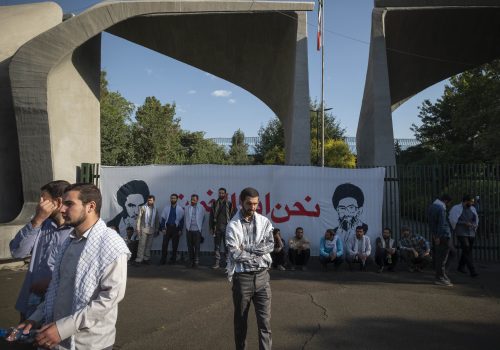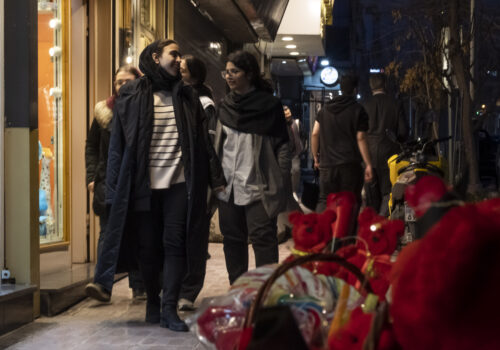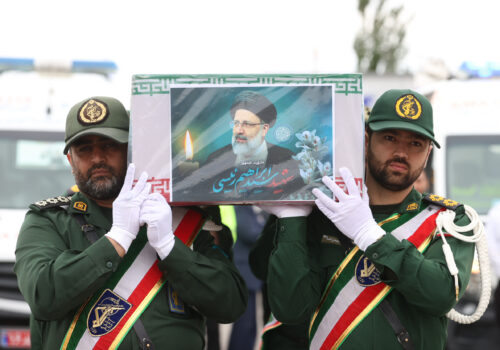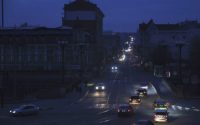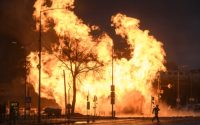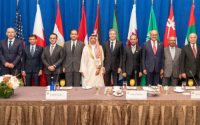Shia Afghans are being brought to Iran to make up for the lack of religious Iranians
According to state-backed media in Iran, more than one hundred thousand Shia Afghan migrants in the Iranian city of Mashhad participated in state-backed mourning processions to commemorate the death of hardline Islamist President Ebrahim Raisi in late-May.
But this is far from a one-off.
In March, the presence of at least twenty thousand Afghan migrants at a state-run event in Tehran to commemorate the birth of the third Shia saint, Imam Hassan—and support the Resistance Axis—caused a significant stir among Iranians.
Some Iranians have also ridiculed the Islamic Republic’s reliance on Afghan migrants to pack Tehran’s eighty-thousand-seat Azadi stadium at a state-run ideological parade, mocking the move as further evidence of the regime’s shrinking support base.
The topic of mass Afghan migration is virtually unavoidable on Iranian streets. The past year has seen a significant influx of Shia Afghans to Iran—something that is visible across every city and even in the most obscure rural areas, such as Khomein, the hometown of Islamic Republic founder Ayatollah Ruhollah Khomeini
SIGN UP FOR THIS WEEK IN THE MIDEAST NEWSLETTER
On the surface, there appear to be two explanations for this sudden surge in migration from Iran’s eastern border: the Taliban takeover in 2021, which caused mass displacement, and the fact that Iran has lost control over its borders—with an Afghan refugee increase of 338 percent since 2021, equivalent to 3.41 million people in just three years.
But the unusual pace with which Afghan refugees have been legally incorporated into Iranian society, despite severe backlash, suggests something greater and more coordinated is at play.
Historically, Afghans have faced state and societal discrimination in Iran. This discrimination prevented Afghans from owning homes, opening bank accounts, or buying cell phones, and Afghans also faced marriage restrictions. However, multiple reports have recently revealed that Afghan refugees en masse have been granted Iranian passports, national identity cards, and full citizenship rights—including the rights to work, vote, and own homes.
While many Afghans have used this avenue, others have taken advantage of recent changes to Iran’s migration laws, which grant immediate “special permanent residence” to foreign nationals “interested in the Islamic Revolution” or who support “the ideals and securing the interests of the Islamic Republic.”
In recent months, the mass participation of Shia Afghans at regime-organized events—including speeches made by the president and supreme leader, state-run Shia Islamist processions, and even rubber-stamp “elections”—sheds light on how the Islamic Republic is proactively using Afghan migrants to foster a loyal constituency and fill the widening gap between the state and Iranian society. As one Shia Afghan migrant declared on state television during the highly engineered March parliamentary elections, which were boycotted overwhelmingly by the Iranian population, “It’s my great honor to come to the ballot box and vote for the Islamic Republic.”
This resembles the clerical establishment’s demographic engineering abroad—repopulating Sunni and Christian neighborhoods in places like Syria and Iraq—where Shia migration, mainly from Afghanistan, has been used to facilitate Tehran’s ideological and security needs. This model not only consolidates the Islamic Revolutionary Guard Corps’ (IRGC) suppressive security apparatus but serves to Islamize societies and change their identities according to Supreme Leader Ayatollah Ali Khamenei’s grand ideological project.
Against this backdrop, the pace at which Afghan Shia migrants have been incorporated into the Islamic Republic’s ideological and propaganda pillars raises serious questions. Is the regime deliberately manufacturing demographic changes in Iran through migration to engineer the supreme leader’s long-held objective of achieving a so-called “Islamic society”?
As Khamenei has repeatedly argued, creating an “Islamic society” can only be achieved after creating a “true” Islamic government. The de facto appointment of hardline Islamist cleric and Khamenei protégé Ebrahim Raisi in the 2021 presidential elections was designed to complete that first step so the regime could move toward an Islamic society, as noted by the supreme leader’s representative to the IRGC.
From the start of the revolution in 1979, the Islamic Republic has taken two approaches to Islamizing Iranian society: from above, through top-down imposition, and from below, focusing on grassroots projects such as establishing Basij militias and mosques in every neighborhood.
Despite all these efforts, Iranian society today is anything but Islamic. A leaked poll conducted by the Ministry of Culture and Islamic Guidance from 2023 revealed that 73 percent of Iranians seek a secular state, contrary to regime propaganda. The Woman, Life, Freedom uprising in 2022 following the killing of Mahsa Jina Amini for “improper hijab” brought these data to life.
Videos of women and men burning the compulsory Islamic veil and the Quran, the torching of mosques and Shia eulogy centers, and the new trend of “turban tossing” to mock the Shia clergy revealed the extent of secularization in Iranian society.
In many ways, the uprising was the final nail in the coffin for Khamenei and his hardline followers’ attempts to achieve an Islamic society among Iranians.
Having tried and failed to Islamize society from above and below, the clerical establishment and the IRGC adopted a new approach to the creation of their ideal Islamic society—Islamization from outside.
Migrants from Afghanistan and other shia comminutes are, in many ways, the perfect candidates for Khamenei to exploit to implement his project of Islamization. The Shia Afghan community is undoubtedly more religiously conservative and observant than the increasingly secular Iranian population—and Tehran is awarding full privileges to committed Shias from Afghanistan.
The current migration figures from Afghanistan underscore that engineering demographic changes in Iran is not a pipe dream for the supreme leader, but a genuine possibility that is within reach.
These figures reveal that there are as many as 6 million Afghan migrants in Iran. However, according to Seyed Hadi Kasai-Zadeh, editor of the journal Meydan-e Azad, if the current trajectory of migration continues, this figure could increase to “20 million in the next three years.” Today, as many as ten thousand Shia Afghans are crossing the border into Iran. These numbers, coupled with mass Iranian emigration—with as many as 2.2 million Iranians leaving the country in 2023 alone—and the country’s historically low birthrate reveal its population will be very different in the coming years.
Iran’s birthrate—which has dropped from 6.4 percent in 1980 to 1.66 percent in 2022—has been a significant cause of concern for the aging ayatollah. In 2013, the supreme leader demanded that Iran’s population increase to 150 million—which he deemed necessary for the establishment of a new Islamic civilization. To achieve this, the regime has employed both incentives for “baby making”—such as providing free housing or high-speed internet to married couples—and forced impositions, such as banning contraception for men and women. An anonymous IRGC official told us that all members of the IRGC must have at least two children or provide medical reasons why they cannot.
In the conspiratorial worldview of Khamenei and the clerical establishment, Iran’s low birthrate is part of a Western plot to decrease the global Shia population and incapacitate the workforce the regime needs to establish its new Islamic civilization. Many in Iran have interpreted the influx of Shia Afghan migrants as Khamenei’s attempt to remedy this. In 2023, the state-run Islamic Republic newspaper reported that, in the fall of 2022, out of 300 births in a hospital in Fars province, 294 were Afghan. These statistics simply cannot be ignored.
But how will Shia Afghan migrants contribute toward achieving Khamenei’s so-called ideal “Islamic society”? One way relates to Islamizing public life in Iran. The regime has long sought to increase attendance at mosques, Shia Islamist eulogy centers (heyats), and public ideological processions—attendance which has been significantly declining among Iranians. For example, during this year’s Nowruz holiday, while large numbers of Iranians opted to celebrate New Year festivities at pre-Islamic, secular historical sites, a reported thirty thousand foreign migrants—the overwhelming majority of whom were Afghan—gathered in Mashhad at the holy shrine of eighth Shia saint, Imam Reza.
Islamic morality policing is another example. As more and more Iranian women and men resist Islamic dress codes, the regime is seeking to actively incorporate Shia Afghan migrants in its efforts to enforce its Islamist “enjoining good, forbidding evil” doctrine, which underpins its morality policing codes.
The final—and perhaps most important—example relates to bolstering the IRGC’s security and paramilitary apparatus. Reports have revealed that the IRGC has been encouraging Shia Afghan migration in Iran to bolster its Shia Afghan proxy, the Fatemiyoun Brigade. This paramilitary force—known as the IRGC’s Afghan Hezbollah—is actively participating in the Iranian regime’s militancy and terrorism abroad, including against Israel and US forces. Regime affiliates have also alluded to using Afghan migrants to suppress future anti-regime protests in Iran.
In the short term, Khamenei might be able to use Islamization from outside to fill the increasing gap between the regime and its people, and to expand his shrinking social constituency. In the medium to long term, however, such demographic manufacturing will inevitably inflame domestic tensions in Iran, further increasing the gap between the Iranian people and the regime and resulting in societal conflict between Iranians and Afghan migrants.
If Khamenei and the IRGC can control this, then they will have a better chance of preserving the Islamic Republic, undercutting the widely held belief that the modernization and secularization of society will inevitably lead to the collapse of the regime. On the other hand, if the regime’s project unravels, it could increase the frequency of mass protests and violent resistance against the regime’s suppression. Either way, domestic instability in Iran is about to get a lot worse.
Saeid Golkar is a senior adviser at United Against Nuclear Iran and UC Foundation associate professor in the department of political science at the University of Tennessee at Chattanooga.
Kasra Aarabi is the director of IRGC research at United Against Nuclear Iran. Follow him on X: @KasraAarabi.
Further reading
Wed, Nov 22, 2023
Meet the secret IRGC entity purging university professors in Iran
IranSource By Saeid Golkar and Kasra Aarabi
The Islamic Republic’s war on university professors and academic staff is led by the Professors Basij Organization.
Fri, Feb 16, 2024
Iran is socially engineering mass depression to suppress dissent
IranSource By Saeid Golkar and Kasra Aarabi
The Islamic Republic has worked tirelessly to strategize and doctrinize control of Iranians’ minds and bodies. But it hasn’t always been successful.
Thu, May 23, 2024
The ‘Butcher of Tehran’ is dead. It won’t change a thing.
IranSource By Khosro Kalbasi Isfahani
Despite his role in crimes against humanity, Ebrahim Raisi’s celebrated death will have no bearing on the Islamic Republic’s policy.
Image: Afghan women hold portraits of their sons and relatives who were members of the Fatemiyoun Brigade, which is a branch of Iran’s Islamic Revolutionary Guard Corps’ (IRGC) Quds force, and killed during the war against ISIS in Syria, during a ceremony for commemorating death anniversary of a Quds force commander in Tehran, December 20, 2022. (Photo by Morteza Nikoubazl/NurPhoto)
